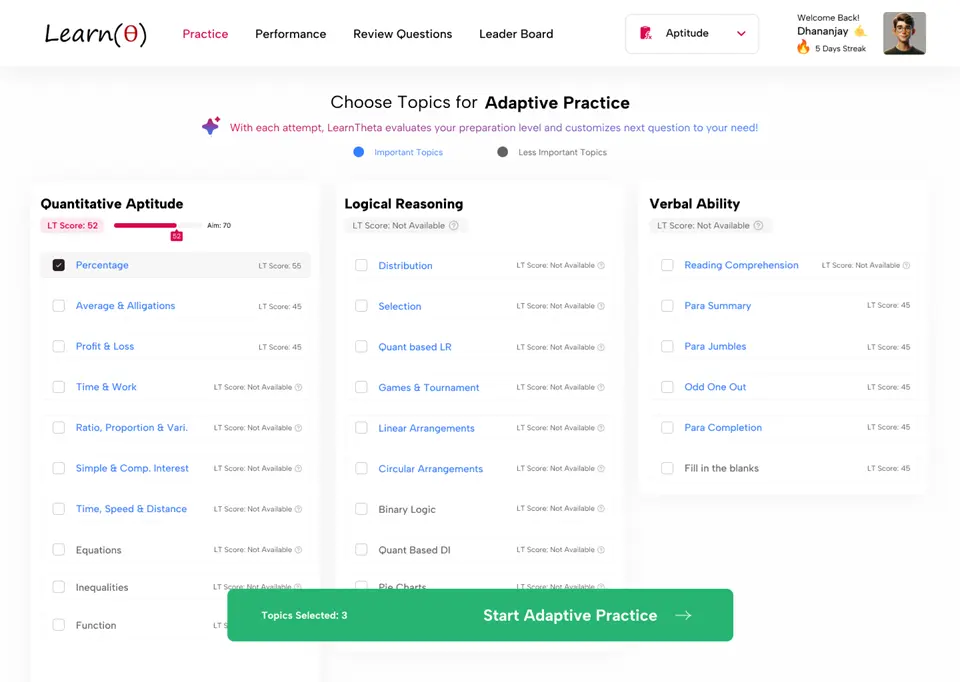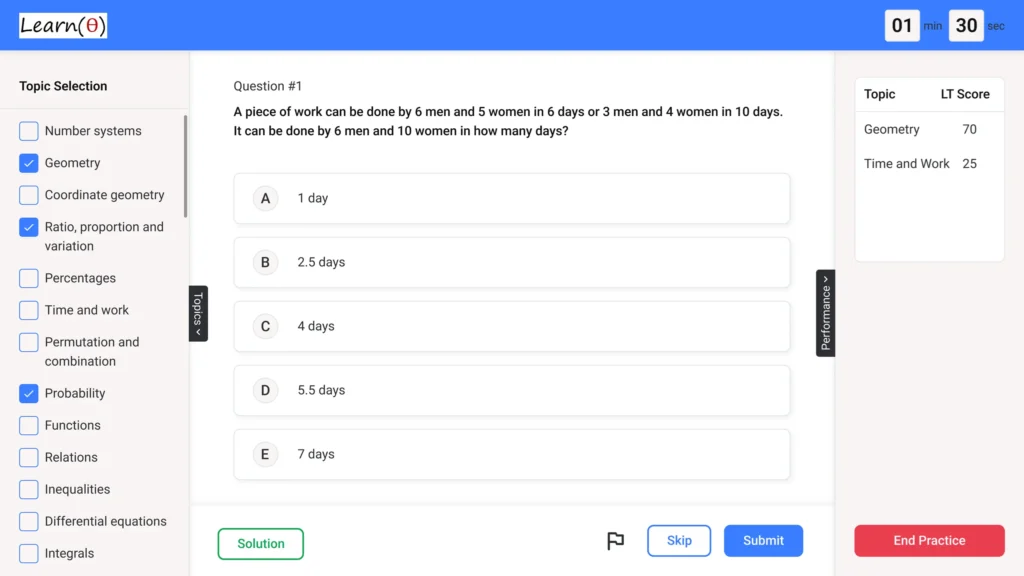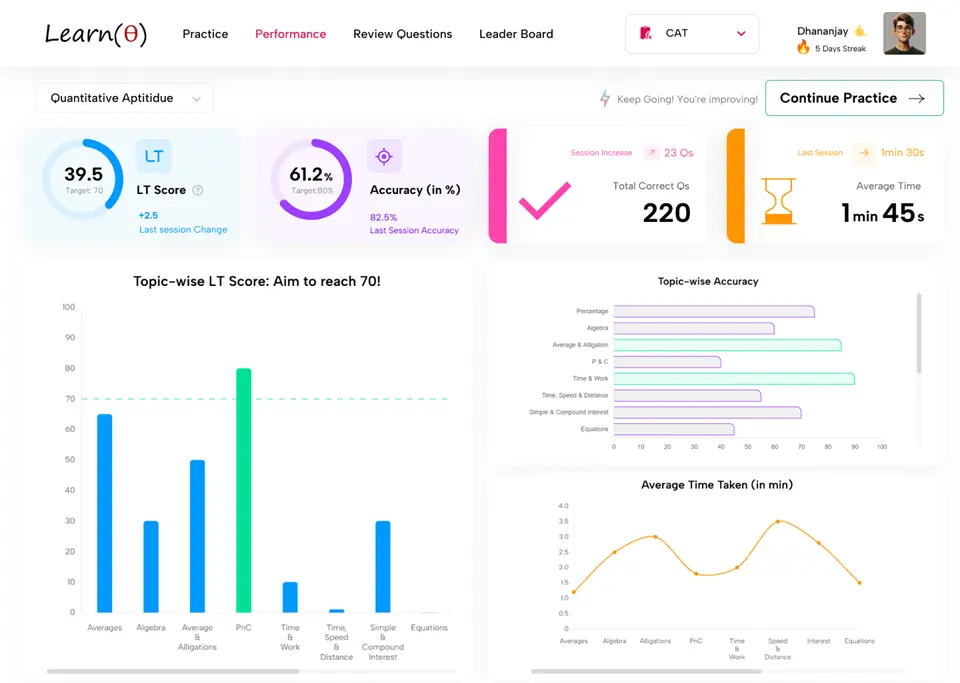Propel Tech – Aptitude Questions & Answers for Placement Tests
Reviewing Previous Year Questions is a good start. Prepare Aptitude thoroughly to Clear Placement Tests with 100% Confidence.
Q.1 Rahul is to the West of Seema. Seema is to the North of Rohan. Rohan is to the East of Priya. Then in which direction is Rahul with respect to Priya?
Check Solution
Ans: A
Drawing a simple diagram helps visualize this. If Seema is North of Rohan, and Rahul is West of Seema, and Rohan is East of Priya, Rahul will be in the North-West direction from Priya.
Q.2 What number comes next in the series: 3, 6, 12, ___?
Check Solution
Ans: C
Each number is double the previous number. 3 * 2 = 6, 6 * 2 = 12, therefore 12 * 2 = 24
Q.3 Pointing to a woman, a man said, “Her mother’s only daughter is my mother.” Who is the woman to the man?
Check Solution
Ans: B
The woman’s mother’s only daughter is the woman herself. Since the woman is the man’s mother, the man is the son of the woman.
Q.4 If in a certain code language, CLOUD is written as HQRWK, then how will SMILE be written in that code?
Check Solution
Ans: B
Each letter is shifted based on the reverse alphabetic order and each letter is +5 positions from the original.
Q.5 Which word does not belong to others?
Check Solution
Ans: D
Carrot is a vegetable, while the others are fruits.
Q.6 Arrange the following words in a meaningful sequence. 1. Seed 2. Fruit 3. Tree 4. Flower 5. Branch
Check Solution
Ans: C
A seed grows into a tree, which has branches. The tree produces flowers, which then develop into fruit.
Q.7 Through the dense forest P. the intrepid explorers Q. for the legendary treasure R. embarked on their perilous journey S. in search of the hidden city
Check Solution
Ans: D
The correct order builds a sensible sentence.
Q.8 A talented artist P: with a brush Q: who was known for his landscapes R: painted a beautiful sunset S: using vibrant colours
Check Solution
Ans: B
QPRS
Q.9 A shopkeeper sells two articles for Rs. 2000 each. On one, he gains 20% and on the other, he loses 20%. What is his overall gain or loss percentage in the entire transaction?
Check Solution
Ans: A
Let the cost price of the first article be x. Then, x + 0.2x = 2000 => 1.2x = 2000 => x = 2000/1.2 = 1666.67 Let the cost price of the second article be y. Then, y – 0.2y = 2000 => 0.8y = 2000 => y = 2000/0.8 = 2500 Total cost price = 1666.67 + 2500 = 4166.67 Total selling price = 2000 + 2000 = 4000 Loss = 4166.67 – 4000 = 166.67 Loss percentage = (166.67/4166.67) * 100 = 4% (approximately)
Q.10 A taxi service charges a fixed amount plus a charge per kilometer. A journey of 10 km costs Rs. 75, while a journey of 15 km costs Rs. 100. What is the cost of a 20 km journey?
Check Solution
Ans: B
Let the fixed amount be ‘f’ and the charge per km be ‘c’. 10c + f = 75 15c + f = 100 Subtracting the first equation from the second: 5c = 25 => c = 5 Substituting c = 5 in the first equation: 10*5 + f = 75 => f = 25 For a 20 km journey: 20*5 + 25 = 100 + 25 = 125
Q.11 Ravi and Rahul can complete a task in 20 days and 30 days respectively. They worked together for 6 days, then Ravi left. Rahul continued working alone for some days and then left. If 60% of the total work was completed, then for how many days did Rahul work alone?
Check Solution
Ans: A
Let the total work be LCM(20, 30) = 60 units. Ravi’s efficiency = 60/20 = 3 units/day, and Rahul’s efficiency = 60/30 = 2 units/day. In 6 days, they completed (3+2)*6 = 30 units. Remaining work = 60 * 60/100 – 30 = 36-30 = 6 units. Rahul worked alone for x days. 2x = 6. x=3. Then Rahul worked for 3+6 days. 60% of work completed = 0.6 * 60 =36 . Work together = 30, remaining = 6 units . 2x = 6 , so x = 3, is the number of days Rahul worked alone. Rahul worked alone for some time before leaving after working with Ravi for six days. Total work done 36 . work together done is 30 . remaining 6 is done by Rahul alone which is 6/2 = 3 days
Q.12 A boat travels downstream from point A to point B in 3 hours. The same boat takes 5 hours to travel upstream from point B to point A. If the distance between A and B is 60 km, what is the speed of the boat in still water?
Check Solution
Ans: A
Let the speed of the boat in still water be ‘x’ km/hr and the speed of the stream be ‘y’ km/hr. Downstream speed = x + y km/hr. Upstream speed = x – y km/hr. Distance = Speed x Time. Downstream: 60 = (x + y) * 3 => x + y = 20 Upstream: 60 = (x – y) * 5 => x – y = 12 Adding the two equations: 2x = 32 => x = 16 km/hr
Q.13 A train travels 100 km at a speed of 60 km/hr. It then travels the next 100 km at a speed of 80 km/hr. What is the average speed of the train for the entire journey?
Check Solution
Ans: A
Time taken for the first 100 km = 100/60 = 5/3 hrs. Time taken for the next 100 km = 100/80 = 5/4 hrs. Total distance = 200 km. Total time = 5/3 + 5/4 = 35/12 hrs. Average speed = Total distance / Total time = 200 / (35/12) = 2400/35 = 68.57 km/hr.
Q.14 A shopkeeper sells mangoes. He sells 6 mangoes for the price of 5. He also gives a discount of 10% on every purchase. If he sells 1000 mangoes and the cost price of each mango is Rs. 10, find his profit or loss percentage.
Check Solution
Ans: D
Let the selling price of one mango be ‘x’. He sells 6 mangoes at the price of 5. Therefore, selling price of 6 mangoes = 5x, so selling price of 1 mango = 5x/6. Cost price of 1 mango is Rs. 10. Therefore, 5x/6= 10 * (1-10/100) = 9. x=54/5 So Selling price of one mango is 54/5 Rs. Cost price of 1000 mangoes = 10 * 1000 = Rs. 10000 Selling price of 1000 mangoes = (54/5) * 1000 = Rs. 10800 Profit = 10800 – 10000 = Rs. 800 Profit percentage = (Profit/Cost Price) * 100 = (800/10000) * 100 = 8% Since none of the answer matches with 8%, there is an error in the question. However, we will assume that his selling price = 5x/6 is same as his price when sold to a customer. Then the cost price of each mango is Rs 10 and sells 6 for the price of 5. So selling price will be = (5/6)*10 = 8.33 Selling Price for 1000 mangoes = 8.33 * 1000 = 8330 Cost price = 10 * 1000 = 10000 Loss = 1670 Loss % = 16.7 %
Q.15 The following line graph shows the percentage profit earned by two companies, A and B, over the years 2018 to 2022. In 2020, if the expenditure of Company B was Rs. 400,000, what was its income?
Check Solution
Ans: A
Profit % = (Income – Expenditure) / Expenditure * 100. For company B in 2020, the profit percentage is 40%. 40 = (Income – 400000) / 400000 * 100. Income – 400000 = 160000. Income = 560000.
Q.16 According to the passage, the completion of the first U.S. transcontinental highway in the 1920s led to:
Check Solution
Ans: B
The passage states that the highway inaugurated a new genre of travel literature, the automotive or road narrative.
Q.17 The passage suggests that travel writing, particularly in the context of colonial expansion, served to:
Check Solution
Ans: C
The passage explicitly discusses how travel writing validated and promoted the ideologies of colonial domination.
Q.18 Based on the passage, what is the primary focus of poststructuralist studies on Victorian women’s travel writing?
Check Solution
Ans: B
Poststructuralist studies focus on the complexities of women’s identities, recognizing the influence of factors like nation, class, and colonial power.
Q.19 The passage suggests that travel writing is a form of:
Check Solution
Ans: C
The passage explicitly discusses travel writing’s relationship to colonial discourse, power structures, and the construction of identity, suggesting that it is more than just personal expression or objective reporting.
Q.20 According to the passage, what is a key aspect that modes of transportation affect in relation to travel?
Check Solution
Ans: C
The passage explicitly states that modes of transportation affect the travel experience and lead to new types of travel writing.
Q.21 A study found that individuals who regularly engage in physical activity have a lower risk of developing certain chronic diseases. Based on this, which of the following statements can be best inferred?
Check Solution
Ans: C
The passage indicates correlation, not causation or absolute certainty.
Q.22 Directions: Read the comprehension and answer the following questions below: The digital age has revolutionized access to information, creating unprecedented opportunities for learning and collaboration. The rise of social media platforms has fostered online communities and enabled instant communication across geographical boundaries. However, this digital transformation also presents challenges. The spread of misinformation and disinformation poses a significant threat to public discourse, while concerns about privacy and data security are increasingly prevalent. Furthermore, the digital divide, the gap between those with access to technology and those without, exacerbates existing social inequalities. Navigating this complex landscape requires critical thinking, media literacy, and a commitment to ethical online behavior. It’s a world where connection and disconnection, knowledge and ignorance, opportunity and risk, are intricately interwoven. Which of the following can be inferred from the first sentence of the passage?
Check Solution
Ans: B
The first sentence highlights the revolutionary change in information access, therefore B is the correct inference.
Q.23 Which of the following, if true, would most likely weaken the author’s argument about the need to bridge the gap between the financial world and the general public?
Check Solution
Ans: C
The author argues for bridging the gap due to lack of understanding and potential resentment. An option that shows the gap is already narrowing would weaken this argument.
Q.24 The author suggests that the financial industry risks becoming a “priesthood” if it remains isolated. Which of the following best exemplifies this risk?
Check Solution
Ans: B
The author’s concern is that the financial industry’s complexity and lack of transparency will lead to resentment and distrust from the general public. Option B directly reflects this by highlighting the lack of understanding.
Q.25 According to the passage, what is the author’s primary concern regarding the financial industry?
Check Solution
Ans: B
The author is concerned about the financial industry becoming a “priesthood, administering to its own mysteries and feared and resented by the rest of us,” indicating a lack of transparency and public mistrust.
Next: Publicis Sapient Aptitude Questions
Refer Company wise Aptitude Questions
Practice 1000s of Aptitude Questions with Answers for Quant, Reasoning & Verbal
Fastest Way to Crack Aptitude Tests – LearnTheta’s AI-Practice!

✅ All Topics at One Place

🤖 Adaptive Question Practice

📊 Progress and Insights